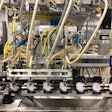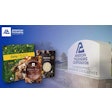Petfood brand owners need packaging that performs. It must protect the product through the bumps and bruises of the supply chain and keep it fresh and appetizing until it reaches the pet's bowl. In a split second, it must grab the consumer's attention on the shelf and convey the producer's selling message.
Multi-wall packaging delivers outstanding value in all these areas. It provides superior protection and freshness; delivers eye-catching marketing impact at point of sale using advanced inks, coatings and graphics technology; and is made from a sustainable and renewable resource base that is highly recycled by an industry offering public and visible commitment to continuous improvement in environmental stewardship.
Petfood is a key market for multi-wall producers. Fiber-based multi-wall sacks dominate petfood packaging in today's marketplace: 83% of petfood packaging was paper-based in 2003. Approximately 16% of US multi-wall shipments went to petfood end uses in 2004, making it the largest single market segment for US multi-wall sack producers. Multi-wall packaging shipments to the petfood segment have increased steadily over the past decade, rising on average 4% per year since 1990.
Environmental stewardship
The suppliers of fiber resources and the manufacturers of paper and forest products in the US are committed to a high standard of environmental stewardship through several highly-visible programs, including:
Commitment to a set of Environmental Health and Safety Principles; a condition of membership in the national trade association, the American Forest & Paper Association (AF&PA).
Participation in the Sustainable Forestry Initiative; also a condition for membership in AF&PA.
Committing as the world's largest recycler of consumer materials; to do even more by setting a goal to recover 55% of paper used in the US.
The Environmental Health and Safety Principles are a set of seven key principles to which every member of AF&PA must subscribe. The emphasis is beyond strict regulatory compliance, aimed at evidencing continuous improvement. Annual progress reports are required and made public. Visit the AF&PA website, www.afandpa.org, for more information.
The Sustainable Forestry Initiative is a broad and comprehensive set of principles to ensure that current needs of the nation's forestlands can be met, while preserving the ability for future generations to meet them as well. It is a land stewardship program that integrates reforestation, nurturing and harvesting, along with conservation of soil, air and water, wildlife and fish habitat and forest aesthetics. It applies not only to forest products producers' own lands, but seeks to influence behavior for the approximately 40% of wood that comes to US paper mills from timberlands owned by others. And the program has teeth. It encompasses:
A third-party certification program;
Compliance verification audit provisions;
Auditor qualification programs;
Independent multi-stakeholder Board of Directors; and
Participation required for AF&PA membership.
Recovered materials
Using recovered materials for papermaking is the longest continuously-running aspect of the paper industry's environmental stewardship history. Today, the US paper industry is the world's largest recycler of recovered consumer materials. More than 270 million pounds of paper are recovered and used by the forest products industry every day: almost one pound on average per day for every man, woman and child in the country.
Recycling is big business for US papermakers. Over half of the paper consumed in the United States in 2004 was recovered: more than was landfilled. This rate is even more impressive considering the expansive geography of the country and the fact that some 10% of the paper used cannot be recovered because it is either used permanently (building construction), ends up in sewage (bathroom tissue) or is highly contaminated (oil filters).
More than three-quarters of all corrugated shipping containers used in 2003 were recovered for recycling to make new fiber-based packaging and other products. Seventy-three percent of old newspapers were recovered that year as well. Not only did they show up as newspapers again, but about 20% of them went into making new packaging products, including 100% recycled folding cartons for petfood products.
While an estimated 48% of office papers were recycled in 2003, substantial potential for growth remains in that area. One of the things you can do personally is to encourage the development of office paper recycling where you work, if it's not happening now. The multi-wall and paper packaging industry has resources to help you. You can get started at www.afandpa.org.
Like you, paper producers are economically motivated. Because recyclables have value for them, US paper and packaging manufacturers have set a goal to increase the recovery rate from its current 50% to 55% by 2012. Already, more than 80% of domestic papermakers use some recovered fiber to make their products.
While not every individual paper product contains recycled fiber or can be economically recovered for recycling today, overall recovered fiber makes up 37% of the raw materials used to make new paper and packaging products in a highly-integrated nationwide system that processes more than 270 million pounds of paper every day.
Petfood and progress
Where do petfood multi-wall sacks fit into this complex economical, technical and logistical system of paper recovery? Certainly we know that there are technical challenges to be addressed. Adhesive contaminants, primarily from hot-melt glues, are extremely difficult to deal with in re-pulping recovered bags. The resulting "stickies" that remain in the recycled sheet decrease its strength, and impair its runability and printability to levels that are unacceptable in the marketplace. The common use of plastic films to provide moisture barriers and the impracticality of re-pulping today's generation of oil- and grease-resistant papers add to the technical challenges.
Yet, progress is being made on several fronts. The highly-variable nature of these stickies is a major reason making their removal difficult. Screening, cleaning, flotation and washing are mechanical means of removal. Used in conjunction with mechanical approaches, chemical approaches using dispersants, polymers and absorbents are the second line of defense. They either make the stickies or surfaces in the mill system passive, or clean stickies off equipment surfaces after deposition. Yet despite technological advances, the difficulty in economically removing stickies through mechanical and chemical means remains a major constraint to increasing the fraction of mixed post-consumer recovered fiber that can be incorporated into recycled paper for many applications.
A next-generation approach currently being explored is the use of enzymes to break down the stickies into "micro-stickies" that don't unacceptably degrade the performance of the recycled paper. While enzymes are naturally-occurring compounds with little adverse environmental impact, finding the right enzyme to break down the range of stickies encountered is proving tricky. Products consisting of patented esterase enzymes have been developed and are currently being tested for three specific applications: mixed office waste, old newspapers and magazines and old corrugated containers.
Polymer technology advances are being developed and applied to offer improved re-pulpability characteristics, allowing for the creation of oil- and grease-resistant properties that can be added to specific layers of a multi-wall bag. This technology would offer new barrier functionality with less dependence upon the plastic films traditionally used in petfood bags, and would provide a multi-wall sack packaging solution for petfood that did not include a fluorochemical base.
Each layer of the multi-wall bag would be dispersion coated with a specific coating, such as oil- and grease-resistance and a moisture barrier. To succeed, new dispersion-coated barrier papers must offer strength properties, print quality, a broad range of basis weights and moisture-resistance performance.
Next generation dispersion-coated barrier papers are now under development and testing in the multi-wall packaging industry, and are being evaluated for market acceptance. While not yet commercially available, these papers have the potential to offer petfood brand owners excellent barrier protection for oil and grease protection; a fluorochemical-free packaging solution; a bright, white appearance; excellent printability; dimensional strength; and FDA compliancy for direct food applications.
But even if papermakers can meet the competing needs of adequate grease resistance and other performance parameters with the available re-pulping technology, another challenge remains to be addressedthe logistical approach to making their recovery economical.
Recovery efforts
There are some applications today where multi-wall sacks are being successfully recovered for recycling. One example is where a multi-wall sack producer works with a major feed producer to recover used multi-wall sacks from several of their plants. Because of the construction of the sacks, and because there is a significant concentration of sacks at few locations, this recycling can be accomplished economically and also offer waste reduction cost savings to the feed producer.
But the key here are the logistical factors that support economic collectability of the used sacks. For multi-wall sacks used at retail that can be recycled at paper mills, curbside collection programs must be developed where they can be recovered along with a fairly broad range of other used consumer packaging. Here's an important area where you can help in your local communities by encouraging the development of new programs and the expansion of existing curbside collection programs, the only broadly-effective channel for recovering consumer packaging, including petfood sacks when they can be recycled.
You can join the paper industry and help the consumers of your products become the better environmental stewards they want to be by taking an active role in your community. Our industry can help you get started. AF&PA offers a guide to recycling in your community: A compendium of "how tos" and best practice suggestions to improve the value of any community recycling program. Visit the recycling section of the paper industry's website, www.afandpa.org, for more information.
So, please know that the multi-wall petfood sacks that you use are part of a complex, economically-driven, renewable and recyclable fiber supply systemone that is managed sustainable by producers who are committed to high standards of environmental stewardship. And as these producers work on pushing the environmental envelope, today's example being the development of next generation re-pulpable oil- and grease-resistant barrier papers.
Remember that you too can help, individually and collectively, by working with local municipalities to develop and expand curbside collection programs. Your efforts can make an important contribution toward reaching our full potential for economic recovery of used consumer packaging to produce the recycled fiber for packaging many of the products that you deliver to consumers.












